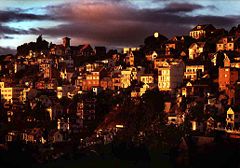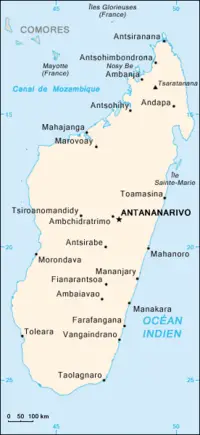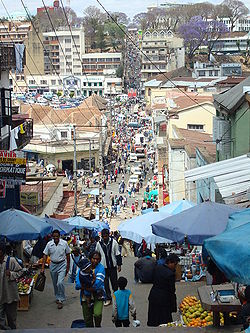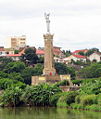Antananarivo
| Antananarivo Tananarive |
|||
| Antananarivo at sunset, March 2005 | |||
|
|||
| Nickname: Tana | |||
| Location of Antananarivo in Madagascar | |||
| Country | Madagascar | ||
|---|---|---|---|
| Founded | 1625 | ||
| Elevation | 1,276 m (4,186 ft) | ||
| Population (2001 census) | |||
| - Total | 1,403,449 | ||
| Time zone | East African Time (GMT+3) (UTC) | ||
Antananarivo (pronounced /ˌtəˌnænəˈriːv/ or /ˌtəˌnɑːnəˈriːv/) is the capital and largest city in Madagascar. It is also known by its French name Tananarive or the colonial shorthand form Tana.
The larger urban area surrounding the city, known as Antananarivo-Renivohitra ("Antananarivo-Capital"), is the capital of the Analamanga region and of the Antananarivo autonomous province.
Geography
Antananarivo, which is Madagascar's largest city and is its administrative, communications, and economic center, is situated in the center of the island length-wise, and 90 miles (145km) away from the eastern coast.
The city occupies a commanding position, being built on the summit and slopes of a long and narrow rocky ridge, which extends north and south for about 2 mi (3 km) and rising at its highest point to about 660 ft (200 m) above the extensive rice plain to the west, although the town is at about 4183 feet (1275 meters) above sea level.
There are two seasons: It is hot and rainy from November to April, with temperatures of 70°F (21°C) in January, and cooler and dry from May to October, 58°F (14°C) in July.
The Ikopa River skirts the capital to the south and west.
Size – land area, size comparison Environmental issues Districts
The city is located 134 miles (215km) west-southwest of Toamasina, the principal seaport of the island, with which it is connected by railway, and for about 62 miles (100km) along the coastal lagoons, a service of small steamers.
History
Unlike most capital cities in southern Africa, Antananarivo was already a major city before the colonial era. The city was founded circa 1625 by King Andrianjaka and takes its name (the City of the Thousand) from the number of soldiers assigned to guarding it. For many years it was the principal village of the Hova chiefs and gained importance as those chiefs made themselves sovereigns of the greater part of Madagascar, eventually becoming a town of some 80,000 inhabitants.
In 1793, it was made the capital of the Merina kings. The conquests of King Radama I made Antananarivo the capital of almost all of Madagascar.
The city was captured by the French in 1895 and incorporated into their Madagascar protectorate. After the French conquest of Madagascar when the city had a population of some 100,000, it was extensively remodeled as the population grew to 175,000 by 1950. Roads were constructed throughout the city, broad flights of steps connecting places too steep for the formation of carriage roads, and the central space, called Andohalo, was enhanced with walks, terraces, flower-beds and trees. Water, previously obtained from springs at the foot of the hill, was brought from the Ikopa River, which skirts the capital.
French colonial rule was sometimes harsh; an uprising in 1947 was suppressed with bloodshed. After independence in 1960 the pace of growth increased rapidly. The military seized power in the early 1970s and set up a socialist state. The economy went into decline and by 1982 the authorities were forced to adopt a structural adjustment programme imposed by the International Monetary Fund.
The city's population reached 1.4 million by the end of the twentieth century.
The city is guarded by two forts built on hills to the east and south-west. Including an Anglican and a Roman Catholic cathedral, there are about fifty churches in the city and its suburbs, as well as a Muslim mosque. Antananarivo hosts a campus of the University of Madagascar and the Collège Rural d'Ambatobe.
Until 1869, all buildings within the city proper were of wood or rushes, but even then it possessed several timber palaces of considerable size, the largest being 120 ft (37 m) high. These crown the summit of the central portion of the ridge; and the largest palace, with its lofty roof and towers, is the most conspicuous object from every point of view.
Since the introduction of stone and brick, the entire city has been rebuilt and now contains numerous European-style structures, including the royal palaces, the houses formerly belonging to the prime minister and nobles, the French residency, the Anglican and Roman Catholic cathedrals, and several stone churches.
Administration
Economy
Antananarivo is the capital of a poor country where, according to World Bank estimates, 70 percent of Malagasy live on less than $1 per day. Poverty and the competition for agricultural land have put at risk the island's dwindling forests, home to much of Madagascar's unique wildlife and key to its emerging tourist industry.
Industries include food products, cigarettes, and textiles.
Financial and business services sector Tourism Manufacturing Transport: Road, rail, air, sea
demographics
ReferencesISBN links support NWE through referral fees
- This article incorporates text from the Encyclopædia Britannica Eleventh Edition, a publication now in the public domain.
Gallery
External links
- Madagascar BBC News Country profiles, Retrieved July 2, 2008.
- Antananarivo Renivohitra Official website.
- Antananarivo, The City Of A Thousand Warriors escapeartist.com, retrieved July 1, 2008.
Template:Antananarivo











